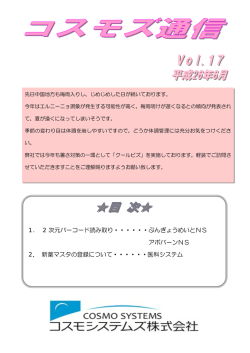
練習問題解答 A.4
戦略的マーケティングのためのゲーム理論 付 録 A 練習問題解答 AKANE Mitsuyuki,"a textbook of game theory",2004 Copyright©2004 Japan Consumer Marketing Research Institute. All rights reserved. 戦略的マーケティングのためのゲーム理論 48 付 録 A A.1 練習問題解答 情報の非対称性 解答 25. 新製品投入ゲーム プレイヤー1が新製品の出来がよい場合に戦略 X、出来が悪い場合に戦略 Y をとることを (X, Y ) と表す。たとえばプレイヤー1が (strong, weak) をと り、プレイヤー2が strong をとる場合の、プレイヤー2の期待利得は次のよ うに計算される。 1 1 · (−4) + · 2 = −1 2 2 このようにして計算すると、利得表は次のようになる。 1\2 strong weak (strong, strong) −3, −1 0, 0 (strong, weak) −1, −1 1, 0 (weak, strong) −2, 3 −1, 0 (weak, weak) 0, 3 0, 0 ナッシュ均衡をもとめると、((strong,weak), weak) および ((weak, weak), strong) となる。したがって、純粋戦略の完全ベイズ均衡は以下の2つである。 • プレイヤー1は新製品の出来がよい場合には strong、出来が悪い場合 には weak をとり、プレイヤー2は weak をとる。 • プレイヤー1は新製品の出来にかかわらず weak をとり、プレイヤー 2は strong をとる。 解答 26. 部分ゲーム完全均衡と完全ベイズ均衡(以下、対抗= battle、協調= acc. ) (1) 部分ゲーム完全均衡: (参入する, もし参入してきたら協調する) (図 A.1 上) ・ (参入しない, もし参入してきたら対抗する)(図 A.1 下)の2つ。 プレイヤー2から始まるゲームは部分ゲームではないので、そこでの戦 略がナッシュ均衡になっている必要はない。したがって、 「もし参入して きたら対抗する」というプレイヤー2の根拠のない脅しは部分ゲーム完 全均衡では排除されない。 AKANE Mitsuyuki,"a textbook of game theory",2004 Copyright©2004 Japan Consumer Marketing Research Institute. All rights reserved. 戦略的マーケティングのためのゲーム理論 A.1. 情報の非対称性 Player 1 enter 強い1 Player 2 battle acc. battle p=1/2 弱い1 (0, 2) not enter p=1/2 自然 49 enter acc. (-1, -1) (1, 1) (-2, 0) (1, 1) not enter (0, 2) Player 1 enter 強い1 自然 Player 2 p=1/2 battle acc. battle p=1/2 弱い1 (0, 2) not enter enter acc. (-1, -1) (1, 1) (-2, 0) (1, 1) not enter (0, 2) 図 A.1: 部分ゲーム完全均衡と完全ベイズ均衡:解答 (2) 完全ベイズ均衡: (参入する, もし参入してきたら協調する)のみ。 AKANE Mitsuyuki,"a textbook of game theory",2004 Copyright©2004 Japan Consumer Marketing Research Institute. All rights reserved.
© Copyright 2024
